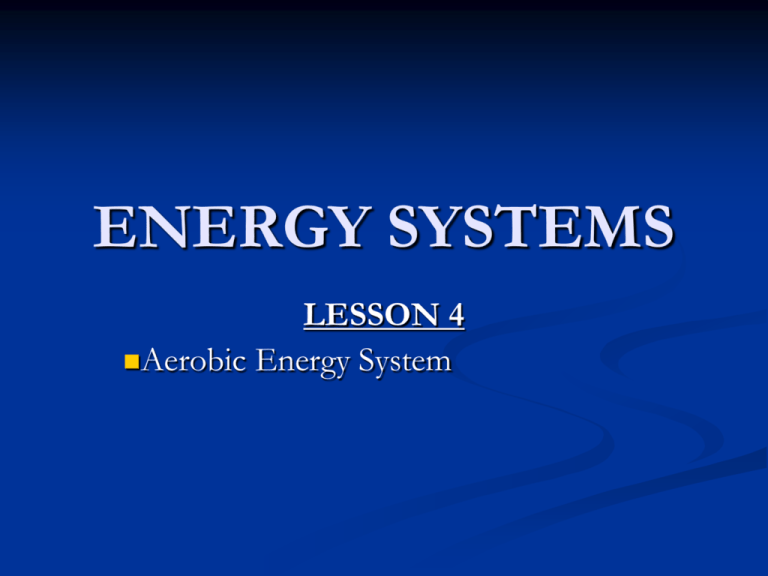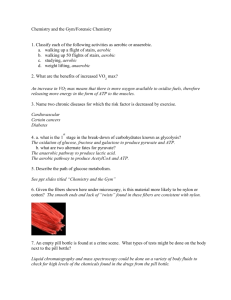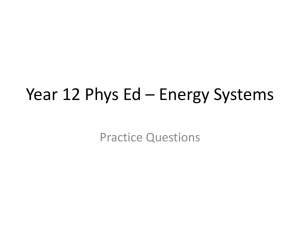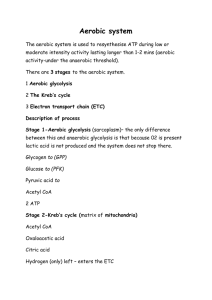ENERGY SYSTEMS
advertisement

ENERGY SYSTEMS LESSON 4 Aerobic Energy System LEARNING OBJECTIVES 1. Am I able to explain the Aerobic System? 2. Can I evaluate the Aerobic System? STARTER Explain the facts about the Lactic Acid System FACTS OF THE LACTIC ACID SYSTEM There is NO Oxygen present!! Therefore, the Lactic Acid System works under Anaerobic conditions The fuel for this system is Carbohydrates (in the form of Glycogen) The reactions take place in the sarcoplasm of the muscle cells The main limitation of this system is the Onset of Blood Lactate Accumulation (OBLA) – which lowers the pH and inhibits enzymes The Lactic Acid system is the predominant energy system for the 400m sprint and for midfield games players that have lots of high intensity sprints with no time for recovery AEROBIC ENERGY SYSTEM Look at sheet provided about the Aerobic System Explain what is happening during: Aerobic Glycolysis Krebs Cycle Electron Transport Chain AEROBIC GLYCOLYSIS This is the same reactions as Lactic Acid System, apart from Pyruvic Acid combines with coenzyme A to form Acetyl CoA due to oxygen being present KREBS CYCLE The Acetyl CoA combines with oxaloacetic acid to form Citric Acid Citric acid is then taken into the Krebs Cycle where: CO2 is produced and removed via the lungs Hydrogen atoms are removed (oxidation) Energy is produced to re-synthesis 2 molecules of ATP Oxaloacetic acid is regenerated ELECTRON TRANSPORT CHAIN The Hydrogen atoms (from Krebs Cycle) Combine with the coenzymes NAD and FAD to form NADH and FADH These are then carried down the Electron Transport Chain where hydrogen is split into H+ and e This takes place in the cristae of the mitochondria where three important events take place: The hydrogen electron (e‾) splits from the hydrogen atom and passes down the ETC This provides sufficient energy to re-synthesise 34 ATP molecules The hydrogen ion (H+) combines with oxygen to form water (H2O) TASK Explain how ATP is re-synthesised in the Aerobic System You must include information on the following: Aerobic Glycolysis Krebs Cycle Electron Transport Chain FATS Triglycerides (fats) are broken down by enzymes termed lipases into free fatty acids (FFA) and glycerol and used as an energy fuel within the aerobic system FFA are broken down into Acetyl CoA, which enters and is broken down by the Krebs Cycle and the ETC in the process termed beta-oxidation FFA produce more Acetyl CoA and consequently produce far greater energy than the breakdown of glycogen/glucose However, FFA’s require 15% more O2 than that required to break down glucose Therefore, glycogen and glucose are the preferred energy fuel during moderate or high intensity activity TRAINING ADAPTATIONS Aerobic training causes a number of beneficial adaptations which help to improve the aerobic energy system’s efficiency to re-synthesise ATP: Increased storage of muscle and liver glycogen Increased metabolism of aerobic enzymes Earlier use of FFA’s as a fuel thereby helping to conserve glycogen stores The net effect of the above adaptations is that they increase/prolong the aerobic threshold thereby increasing the potential intensity of performance This delays muscle fatigue by increasing the intensity at which the onset of blood lactate accumulation is reached and by maximising its efficiency to remove lactate during periods of recovery ADVANTAGES OF THE AEROBIC ENERGY SYSTEM Large potential glycogen and Free Fatty Acids (FFA) stores available as an efficient energy fuel Efficient ATP re-synthesis when good O2 supply guarantees breakdown of FFA Large ATP re-synthesis. 38 ATP from one molecule of glucose, compared to 2 from LA system and 1 from ATP/PC system Provides energy for low/moderate intensity, high duration exercise (3 minutes to 1 hour) No fatiguing by-products. CO2 and H2O are easily removed DISADVANTAGES OF THE AEROBIC ENERGY SYSTEM Slower rate of ATP re-synthesis compared with LA system Requires more O2 supply (15% more for FFA) More complex series of reactions Cannot re-synthesise ATP at the start of exercise due to initial delay of O2 from the cardiovascular system Limited energy for ATP during high intensity, short duration work FACTS OF THE AEROBIC SYSTEM The Aerobic System works under Aerobic conditions The fuel for this system is Glycogen or Fat as well as requiring Oxygen to function The reactions take place in the sarcoplasm of the muscle cells, Matrix of the Mitochondria and Cristae of the Mitochondria PLENARY Explain how the three energy systems would work throughout a Football match







